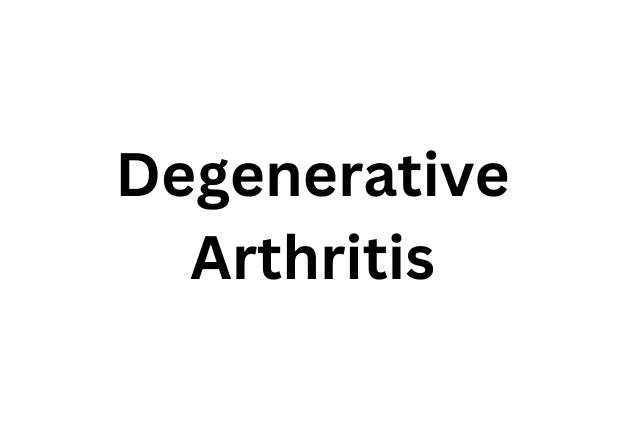What is Degenerative Arthritis?
In your joints, there is connective tissue called cartilage. Cartilage is both firm and flexible. During movement, stress to the joints (pressure and shock) is absorbed by cartilage.
Degenerative arthritis (DA) (or osteoarthritis) happens mainly because of aging. Damage to joints happens due to repetitive use of joints over the years. Cartilage begins to be composed more of water than of protein, and degeneration occurs.
Causes of Degenerative Arthritis
DA is caused by the normal breakdown of cartilage over time. The cartilage is normally slick and slippery and allows joints to move almost without friction. The surface of cartilage becomes rough in DA. If the cartilage is completely worn away, bones will rub together. If joints become infected or are injured, DA can be worsened.
Symptoms of Degenerative Arthritis
Compared to inflammatory arthritis (see Inflammatory Arthritis article), DA develops with age, and is thus more common in people who are aged 65 and older. Symptoms may be worse in the morning.
These symptoms include:
- Pain in joints (arthralgia)
- Tenderness of joints
- Swelling in joints
- Stiffness of joints
- Decreased range of joint motion
- Skin redness around joints
- A grating sensation when using the affected joint(s)
Risk factors of Degenerative Arthritis
There are some factors that increase the chances of getting DA, including:
- Family history of arthritis
- Being over the age of 65
- Being a woman
- Being overweight
- Injury to joints
- Infection of joints
- Having been born with bone or cartilage defects
- Being in occupations with repetitive stress to certain joints
- Having gout or rheumatoid arthritis
Diagnosis of Degenerative Arthritis
Your reported symptoms, a physical examination, and imaging techniques for bones and cartilage, including X-ray, CT and MRI scans, are used by physicians to diagnose DA.
Early diagnosis and accuracy of the diagnosis is important for successful treatment and for the prevention of permanent joint damage and disability.
Treatment of Degenerative Arthritis
Treatment is used to reduce pain and prevent further damage to joints. Joint function can also be improved by treatment.
Medication
- Analgesics (e.g., acetaminophen (Tylenol)) and creams containing menthol or capsaicin help to reduce pain
- Nonsteroidal anti-inflammatory drugs (NSAIDs) (e.g., ibuprofen (Advil) or naproxen sodium (Aleve)) reduce both pain and inflammation
- Fulranumab is a promising new medication for DA that is currently in clinical trials. It is a human antibody (a type of protein) that is designed to reduce pain.
- Stem cell therapy is a treatment that is being developed, in which the introduction of adult stem cells into areas with cartilage damage is used to replace the damaged cartilage.
- For severe OA cases, opioids may be prescribed (e.g., Vicodin) and/or medical marijuana
Splints, hot/cold packs, braces, shoe inserts, assistive devices (e.g., canes and gripping devices), and paraffin wax dips are additional treatments for arthritis.
Surgery and medical procedures
- Tendons that have been loosened or damaged can be repaired in affected joints by a surgeon.
- For advanced arthritis, the affected joint can be replaced by an artificial joint by surgery. This is usually used for replacement of affected knees and hips. Surgeons usually recommend quitting smoking after replacement surgery (and even before surgery) in order to allow for optimal bone healing.
- For severe arthritis in fingers or wrists, a surgery called joint fusion can be used in which bones are locked together until they are healed into one.
- Cortisone shots, in which corticosteroid medications are injected into affected joints, are used for pain relief.
- Hyaluronic acid, a substance that mimics joint fluid, can be injected into knees to provide a cushioning effect and pain relief.
- RF (radiofrequency) ablation is a procedure that can be used to reduce pain. The targeted area is heated up using an electric current that is generated by a radio wave. This heating decreases the signals of pain from the area.
- Prolotherapy (proliferation therapy) is a nonsurgical way to reconstruct ligaments and tendons. It works through the stimulation of natural healing processes in the body that produce new cartilage in the damaged areas. This therapy involves repeatedly injecting irritating solutions into the targeted areas to stimulate a regenerative response. Platelet Rich Plasma (PRP) injection is a type of prolotherapy.
Physical therapy
Exercises, including aquatic therapy, can be used to strengthen muscles that surround affected joints, improving the range of motion. For DA in the knees and lumbar spine, stationary biking is a helpful exercise. Physical and occupational therapists also provide ways to complete daily activities that lessen the impact on affected joints at home and at work.
Yoga and tai chi are movement therapies that involve gentle stretches and deep breathing.
Diet
Diet does not generally play a large role in causing arthritis or making it worse. Some dietary supplements, such as omega-3 fatty acids, glucosamine, and curcumin, have been reported to have relieving, anti-inflammatory effects.
Those with arthritis who also suffer from celiac disease can also experience worse joint pain if they consume foods containing gluten.
Prevention of Degenerative Arthritis
Most types of arthritis have an inherited component, and therefore cannot be prevented. Arthritis caused by joint injury can be prevented by being vigilant about safety in all activities at home and work. The prevention of infections causing arthritis is another strategy.
References
Constance R. Chu, Michael B. Millis, Steven A. Olson. “Osteoarthritis: From Palliation to Prevention.” J Bone Joint Surg Am. 2014;96(15):e130.
Yves Henrotin, Ali Mobasheri, Marc Marty. “Is there any scientific evidence for the use of glucosamine in the management of human osteoarthritis?” Arthritis Res Ther. 2012;14(1):201. doi: 10.1186/ar3657.
- Sanga, N. Katz, E. Polverejan, S. Wang, K.M. Kelly, J. Haeussler, J. Thipphawong. “Efficacy, safety, and tolerability of fulranumab, an anti-nerve growth factor antibody, in the treatment of patients with moderate to severe osteoarthritis pain.” Pain. 2013;154(10):1910-1919. doi: 10.1016/j.pain.2013.05.051.



